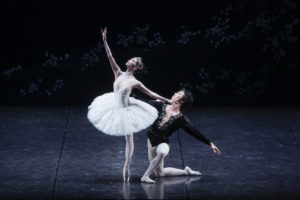Tokyo: Where ballet burns brightly - Vancouver Ballet Society
- Home
- City Reports 2020 - 2023
- Tokyo: Where ballet burns brightly

By Naomi Mori
Tokyo City Ballet’s Swan Lake is noteworthy for the stage design by École de Paris painter Léonard Foujita, who created it for the first ever Japanese production of Swan Lake in 1946, for Tokyo Ballet (not the same company that is currently active) when Tokyo was still in the aftermath of World War Two. The vivid and lively designs, long believed to be lost, were recently discovered and the artwork revived in 2018.
The choreography was created in 1969 by Taneo Ishida, the company founder. Two of the three performances at Tokyo Bunka Kaikan concert hall in mid-August were by guests — première danseuse Hannah O’Neill and étoile Germain Louvet of Paris Opera Ballet — with the third by Haruka Sassa, a former dancer with Tokyo City Ballet and currently a principal at Norwegian National Ballet. Due to COVID-19, there were multiple cast changes and her partner, a company principal, was replaced by Ryo Yoshidome, a soloist. Yoshidome’s Prince was fabulous, with good partnering skills and soft landings, and he was promoted to principal at the curtain call. Sassa was a beautiful Odette, long-lined and lyrical, while O’Neill and Louvet were both elegant.

When the ballet season started in September, K-Ballet Company, led by former Royal Ballet principal Tetsuya Kumakawa, performed a contemporary triple bill titled Petit Collection, through a new initiative called K-Ballet Opto. Led by Rei Watanabe (formerly a dancer at Nederland Dans Theater), Opto (light) was formed to bring new modern choreography to the K-Ballet dancers, and to provide a forum for collaboration with other arts. The performance was at KAAT Kanagawa Arts Theatre Hall in Yokohama, a short train ride from their usual Tokyo home theatre.
K-Ballet usually dances full-length classics, so this was a rare opportunity for the dancers to perform modern works, with two world premieres. The first was Watanabe’s Petit Baroque for mainly female dancers, who quickly took off their high heels to dance barefoot. Nozomi Iijima, a former principal dancer with Houston Ballet, stood out with her sharp speedy movements, showing women’s power and strong will.

In the second premiere, Petite Maison by Yuki Mori (a former director at Theater Regensburg in Germany), the theme was the fragmentation of people, set to Rachmaninoff’s Rhapsody on a Theme of Paganini. The stage design consisted of wrinkled black and white paper covering the floor, with the dancers wearing either black or white, representing angels and demons. How could they get along together? This was a thought-provoking work with humour.
Opening the evening, Medhi Walerski’s Petite Cérémonie, created for Ballet BC in 2011, was stylish and playful, with the dancers in formal evening wear rushing about and playing with boxes. The choreography in all three should have been a breath of fresh air for the K-Ballet dancers.

K-Ballet Opto will present another modern program in January called Plastic, tackling the issue of single-use plastics. Two world premieres are on the bill, choreographed by Alessio Silvestrin (an Italian who is a long-time resident of Japan) and Watanabe.
The Tokyo Ballet, which tours Europe annually, performed La Bayadère by Natalia Makarova in October, a version introduced to their repertoire in 2009. This time round, former American Ballet Theatre star Julio Bocca — a notable Solor, who danced the Bronze Idol in his first year with ABT — was invited to coach them, successfully adding more dramatic depth to the dancers’ interpretations.

There were three casts in the role of Nikiya: veteran principal ballerina Mizuka Ueno, rising star Akira Akiyama, and young second soloist Eriko Nakajima, who joined the company last year. Each gave a lovely interpretation of the role. Ueno’s gorgeous long lines and strong technique were in evidence, while Akiyama was an expressive, lyrical Nikiya. Nakajima, with well-proportioned long limbs and arched feet, seemed a little nervous but showed much promise for the future.
In the iconic Kingdom of the Shades scene, the serene, ethereal corps de ballet was beautifully unified. It was a moment of pure bliss. Shoma Ikemoto, who danced the Bronze Idol on opening night, deserves special mention for his amazing ballon and controlled turns.
The National Ballet of Japan opened their fall season at the New National Theatre, Tokyo with a new production of Giselle, directed by artistic director Miyako Yoshida and choreographed by Alastair Marriott, a former colleague at London’s Royal Ballet when they were both dancers there.

The aim was to create a traditional Giselle authentic to the original 19th-century Romantic style and plot, but with the British dramatic style that tells the story through movement. The choreography featured upper body épaulement and fast footwork reminiscent of the Ashton style of choreography. For the graveyard scene, designer Dick Bird (who has designed many productions for ballet and opera) featured numerous little crosses on a hill, inspired by the Lithuanian Hill of Crosses, an ancient World Heritage site with hundreds of thousand of crosses, creating a strangely haunting setting. A backstage tour of the set with Bird is available here.
Principals Ayako Ono and Yui Yonezawa excelled in their portrayals of the fragile and innocent Giselle. With their musicality, polished classical technique, and lightness, they are ballerinas who should be known internationally.

